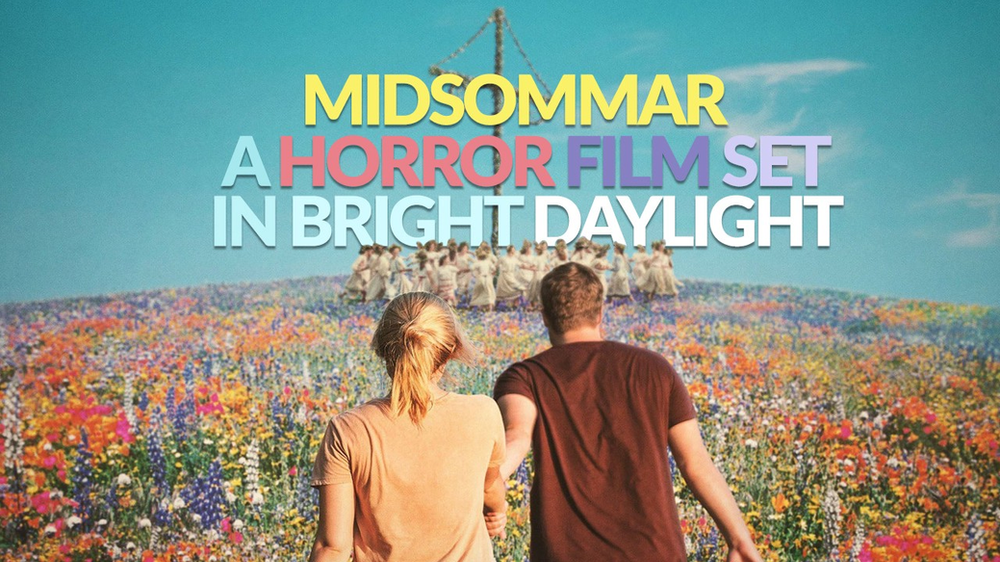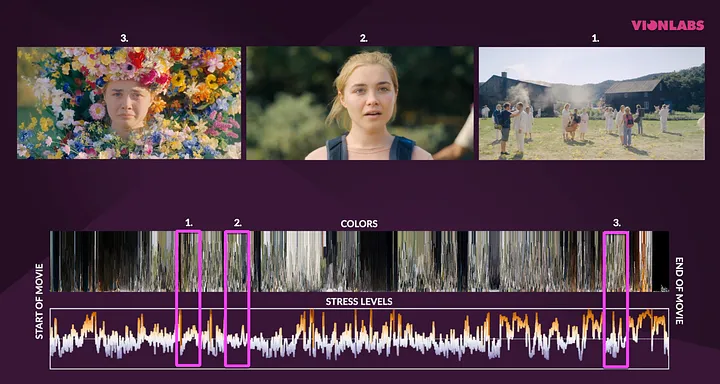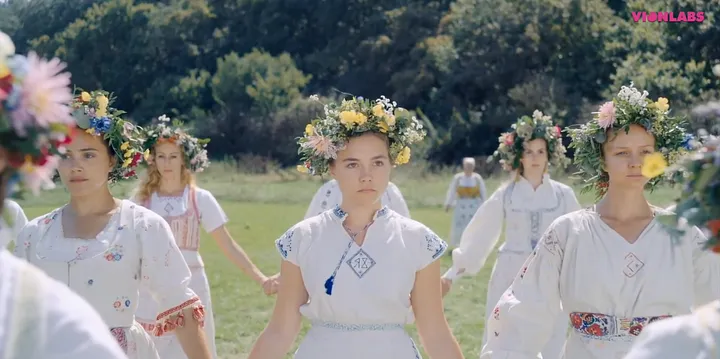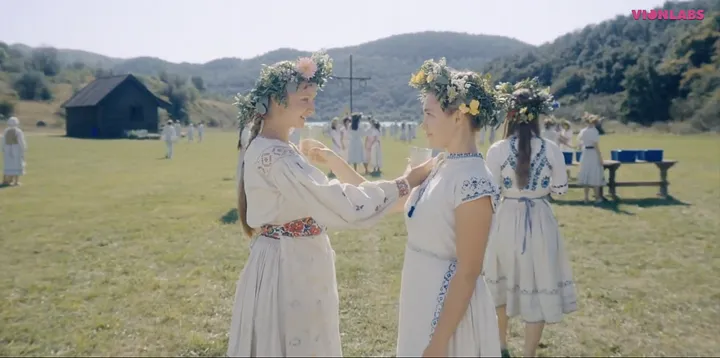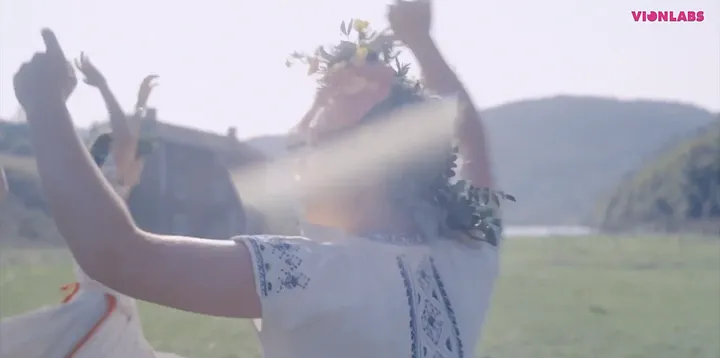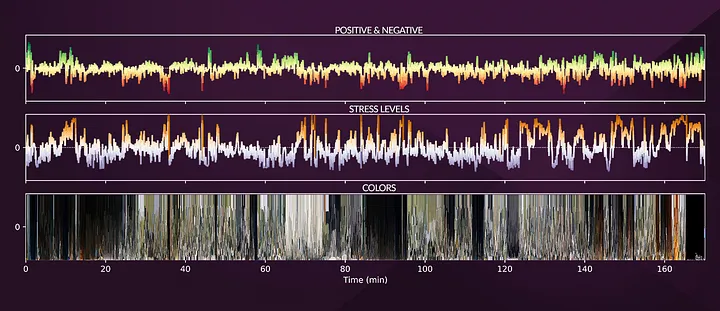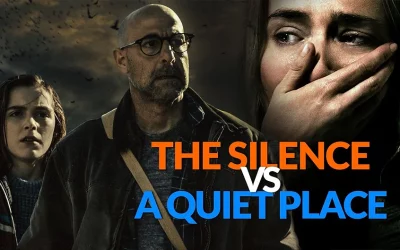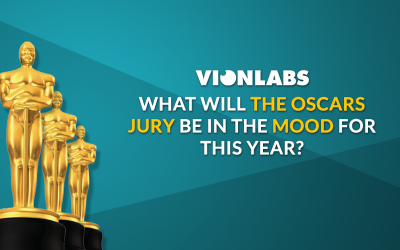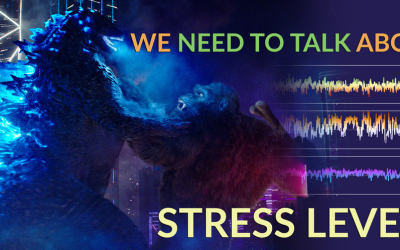Cognitive AI used to create a deep color analysis of Ari Aster’s motion picture Midsommar.
As we are entering a whole new era of streaming, with services fighting to stand out from their competition, it becomes increasingly clear that in order to fully know your customer, you also need to know your content. By observing patterns in a range of variables such as the colors, pacing, audio, or stress levels of what your customer is viewing, you can find valuable information that will help you provide them with better recommendations and increase the time they spend engaged on your platform. As previously discussed in the article “How Movies Use Color To Create Emotion”, OTT services can truly benefit from a deeper understanding of color’s effect on emotion and how this can be used to connect with their user base. To further illustrate its importance, we have applied our internal movie-buff knowledge combined with Vionlabs’ Emotional Fingerprint technology to create a deep color analysis of Ari Aster’s motion picture Midsommar (Aster, 2019) which, compared to other horror movies, separates itself in its use of color. Midsommar is a vibrant break-up movie set in the land of the midnight sun — bright daylight, striking yellows and greens, nature, and captivating whites blasting at you everywhere you look. This is a stark contrast to what audiences might be expecting when they think of the horror genre, but the film ultimately still succeeds in its mission to creep us out. With a deeper understanding of how this is done, combined with knowledge of the movie’s different variables an OTT service could make sure this uneasy desaturated technicolor metaphor of heartbreak lands in front of the right customer at the right time.
Why Horror Has Become Synonymous With Darkness
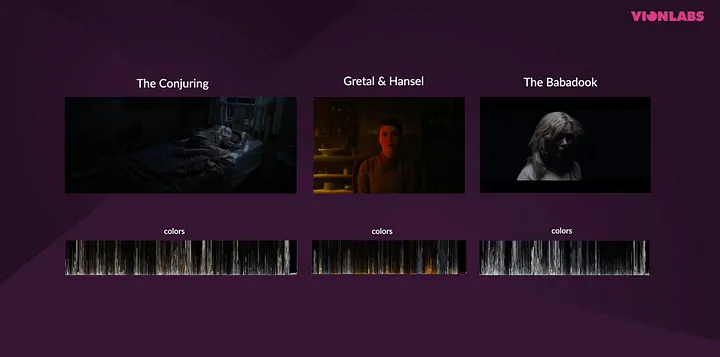
Midsommar: A Technicolor Horror Film – AI Movie Color Analysis
But what happens when a movie does something unexpected? To illustrate this we will take a closer look at one movie that deviates from the norm, Midsommar — a technicolor horror film. We are used to horror films being set in the dark, but here it is quite the opposite. Let’s take a look at how the film manages to make us feel uncomfortable despite having a color palette that on its own might make us think we’ve been placed inside a joyful dream.
In order to fully supply you with a deep analysis of Midsommar, the rest of the article will include spoilers, so if you haven’t seen the movie yet, make sure to start there before you read onward.
The film follows the disintegrating relationship of a couple, Dani and Christian. Christian wishes to break up, but before he can, something tragic happens to Dani. Christian, who now feels bad about dumping her, invites her to travel to Sweden together with his friends to visit the character, Pelle’s rural hometown, Hårga, and participate in its fabled, once every 90-years, midsummer festival. But what is supposed to be an idyllic retreat quickly escalates into an increasingly violent and truly bizarre pagan ritual. Midsommar is Ari Aster’s second movie, and a follow-up of his folk horror film Hereditary (Aster, 2018). In Hereditary, Ari Aster and his cinematographer Pawel Pogorzelski exploited the dark. They explored just how dark could get. In Midsommar however, they have flipped a full 180 and we are left unsettled by what can hide in plain sight.
Using Symbolism to Play Upon Our Fear of Ritual
While the story in itself uses several techniques to play upon what frightens us, the Hårga commune’s way of life alludes to our fear of ritual. In our modern secular age, we have grown weary of the spaces in which ritual exists. In everything from the Hårga’s synchronized eating habits, the way in which they pick their flowers while walking backward or how they toast before they drink, to the collective way in which they experience pain, you can tell that there is a certain way in which things should be done, and the entire group seems to act like one single unit. The film plays upon this fear of ritual but also showcases how ritual can benefit us — giving us a sense of purpose, comfort, community, and tools for dealing with life. Like Pelle says when he is speaking to Dani about the loss of her parents; he lost his parents too, but never once did he feel as if he wasn’t loved or held. The film also uses symbolism to foreshadow what’s to come. The paintings on the walls around them constantly tell us what will happen to our protagonists. Aster allows this to be a part of the story the same way his violence is, it is bright, clear, and out in the open. Despite knowing what will happen, we as viewers can’t seem to look away, the same way the last stages of a breakup can feel like a trainwreck you are unable to take your eyes off it. .
Haptic Visuality and Overexposed, Desaturated Colors
In Midsommar, the shots are overexposed, and the sunlight is constantly poking through as if you’re walking around with the sun in your eyes, unable to see clearly. The lens flares help perpetuate what we already know, that the characters can’t see clearly what will happen to them. We are left to watch in horror as they face what we already know is coming. The colors are desaturated, contributing to the film’s dreamlike state. Everything, from the upside-down shot as they enter Hårga to the prevalence of hallucinogenic drugs, blends masterfully with the over-exposed, desaturated technicolor theme throughout the movie, making us in turn feel as if we’ve lost hold of reality. And with dreams you are always left to wonder, could this be a nightmare? This is how Aster introduces haptic visuality to the viewer without using the component of darkness. Overexposed shots, shots of characters experiencing life through a drugged lens, as well as the brightly lit gory close-ups featured in certain scenes bring sensations of tension and suspense to the body. One can’t help but physically flinch when one hears the screams of the Hårga people as the sacrificial building burns to the ground in the closing scenes.
AI Movie Color Analysis: Midsommar – Color Themes
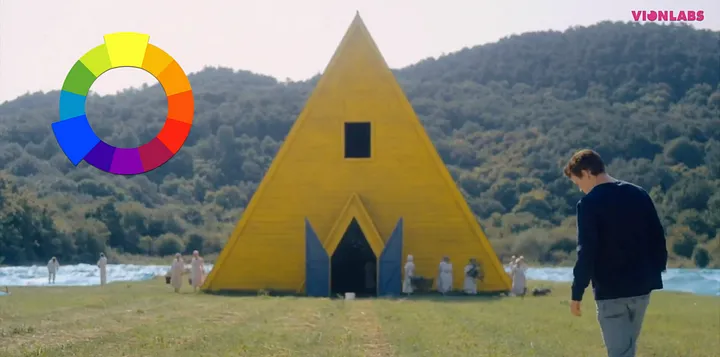
“From the dizzying and near-perpetual sunlight to the clothes worn by the Hårga, whiteness symbolizes the unity of the cult. Color, on the clothes of the outsiders and especially on the skin of Josh and British visitors Connie (played by Ellora Torchia) and Simon (Archie Madekwe), is an instant visual cue of otherness.”

Aster uses the color white to show us the alienation and otherness of our main characters. This becomes especially apparent when Dani is crowned the May Queen, Christian being the only person in these shots dressed in darker clothing. His alienation, alongside his bad trip, instills an uneasy feeling in us. We know he doesn’t belong to the group and we’re anxious to see what will happen to him.
Violence As a Truly Haptic Visual Experience
As mentioned earlier, Aster’s violence is played out right before our eyes, allowing us to take in the full extent of the blood, the flesh and the gore. The bright color scheme ensures that there is nothing for us to hide behind as we encounter the Hårga people’s violence, resulting in a truly haptic visual experience.

When researching our attraction to scary movies, experts have found something called the “excitation transfer theory” to be at play. While watching something scary or uncomfortable happen on screen, research shows that our heart rate, blood pressure and respiration all increase. Excitation transfer theory states that the uncomfortable feelings and sensations we experience actually increases the relief and satisfaction we feel when said horrific event is over, contributing to a higher enjoyment of the film. Allowing your audience to fully experience a violent aspect can thus intensify these feelings. With this, Ari Aster shows us that horror doesn’t have to take place in hidden spaces, covered in darkness. Sometimes the most horrific acts can be performed right before your eyes.
Emotional Fingerprint Data Analysis
Vionlabs’ AI-driven Emotional Fingerprint+ measures several important variables of a movie to produce deeper analysis and data that OTT services can use to better understand their content as well as their users. The graphs above showcase Midsommar’s stress levels, color scheme as well as the positive and negative feelings associated with the content. While watching this in theatres several people decided to leave when the first gory images appeared on the screen. The stress levels connected to this scene are high and enable the OTT provider to trace a potentially similar pattern while observing their user’s watch history. Using this information and comparing it to other content data can help you find the patterns interesting to a specific user. Do they happen to like a film for the specific actor involved, or are they maybe into really bright colors? Maybe you noticed that they turned the movie off when stress levels got too high and you notice this keeps happening every time they watch something too stressful between 9–11 PM in the evening. With this valuable deeper analysis, you can provide your users with better content recommendations, and a personalized platform. Read the original article here: https://medium.com/vionlabs-tech-blog/how-the-movie-midsommar-is-creepy-despite-not-being-dark-418d719bee72
FAQ for Vionlabs AI Movie Color Analysis: Midsommar
1. What is Vionlabs’ Fingerprint+ technology?
- Fingerprint+ is an advanced technology developed by Vionlabs that analyzes multiple aspects of video content, including color, pacing, and audio. This analysis helps streaming services understand content deeply to make precise recommendations to viewers.
2. How does color analysis enhance streaming service recommendations?
- By analyzing the emotional impact of colors in a movie, streaming services can better understand how these elements affect viewer engagement. This deep understanding allows platforms to tailor recommendations that resonate more effectively with individual preferences and emotional responses.
3. What unique insights does Vionlabs’ technology provide about “Midsommar”?
- Vionlabs’ technology conducted a detailed color analysis of “Midsommar,” revealing how its bright and vivid color palette contributes to the film’s unsettling atmosphere, despite its departure from traditional horror aesthetics which typically use darker colors.
4. Why is “Midsommar” considered a technicolor horror film?
- Unlike typical horror films that use darkness to evoke fear, “Midsommar” utilizes a bright, overexposed visual style with desaturated colors to create a dreamlike and disorienting effect, which is pivotal in delivering its horror elements in broad daylight.
5. Can Vionlabs’ Emotional Fingerprint technology predict viewer preferences?
- Yes, Vionlabs’ Emotional Fingerprint technology can predict viewer preferences by analyzing emotional responses to different cinematic elements. This allows streaming platforms to optimize their content offerings and recommendation algorithms based on emotions.
6. What is haptic visuality and how does it apply to “Midsommar”?
- Haptic visuality refers to the ability of visual media to evoke physical sensations in the viewer. “Midsommar” achieves this through its use of intense visual stimuli, such as overexposed shots and unsettling close-ups, which enhance the viewer’s physical and emotional response.
7. How do the colors yellow and blue symbolize themes in “Midsommar”?
- In “Midsommar,” yellow represents youth and sacrifice, while blue signifies age and ritual. These colors are used strategically throughout the film to underscore the narrative’s themes of life cycles and ritualistic traditions.
8. What role does violence play in the film’s impact, according to Vionlabs’ analysis?
- Violence in “Midsommar” is portrayed in bright, vivid detail, which according to Vionlabs’ analysis, intensifies the viewer’s emotional reactions and engagement, making the scenes more memorable and impactful.
9. How does Vionlabs’ Cognitive AI benefit streaming services?
- Vionlabs’ Cognitive AI helps streaming services by providing deep insights into content and viewer preferences, enabling better content recommendations, increased viewer engagement, and tailored marketing strategies.
